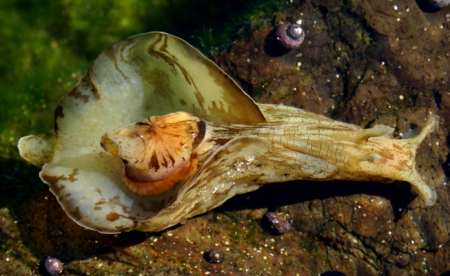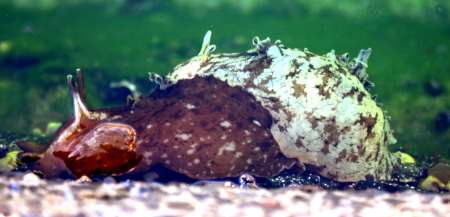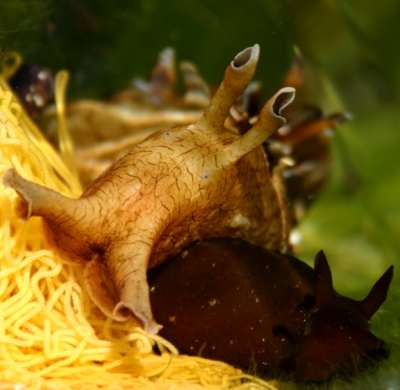Aplysia sydneyensis from eastern Australia
August 5, 2005
From: Francis Hawkshaw


Hi!
I have sent you these photos taken 1st August 2005 and 2nd August 2005, these photos were taken at Kiama on the south coast of New South Wales [eastern Australia]. They were taken at the saltwater rock swimming pool ... and are part of my collection of 60 plus photos of sea slugs.
There are a lot of sea slugs at this time of the year feeding and breeding in the moss and green weed in the pool, there seems to be several species as there is a marked variation in colour .. .there are few human swimmers and the winter sea water is very clear so this may affect the breeding cycle .
The photos were taken from above the waterline .
If possible I would like this species identified and would like more information on them. Are there male and female and does the sex (Male or female) depict the colour or are they hermaphrodites ? Are they like chameleons and can change colour with the environment or light. In the upper photo I see an area on the back with what appears to be the spaghetti like egg casings and eggs - is this usual?
In the lower photo eggs it is possible to see the eggs in the spaghetti-like casings plus two different coloured slugs, Is it usual for them to place these eggs at just below the waterline so that they have some access to sunlight?
Some of the sea slugs seem small (possibly juveniles), some seem large so is there a size range?
I would be happy to share the sea slug images with others so look forward to your reply.
Francis Hawkshaw (Mrs)
Kiama Heights, 2533.

Dear Francis,
Thanks for this interesting series of photos of the Sea Hare Aplysia sydneyensis. If you go to the General Topics index you will find a list of pages on Sea Hares which should answer most of your questions in more detail than I will here. In brief, all sea slugs are hermaphrodites. In your middle photo there are two animals mating, the front one acting as female and the back one as male, but as you will see on the mating chains page, they often form chains where animals act as male and female simultaneously. As far as I know they don't change colour, at least not quickly as a chameleon. There is some evidence to suggest that some Sea Hares change colour depending on the algae they are feeding on, but we need more research before we can say whether that is so.
Concerning size variation. It is possible that your have adults and juveniles together, and it is also possible you may have more than one species present. I suspect the datr brown animal in your lower photo is Aplysia juliana, but I can't see enough to be sure. The things you can see in the upper photo are the organs of the mantle cavity, mainly the orange gill and the flap of tissue that encloses the small flattened shell these animals still retain.
Best wishes,
Bill Rudman
Related messages
-
Aplysia sydneyensis - chain mating
From: Leanne & David Atkinson, January 31, 2007 -
Aplysia sydneyensis from eastern Australia
From: Sascha Schulz, September 14, 2005 -
Colour form? of Aplysia juliana
From: Paul Furneaux, November 12, 2003 -
Aplysia sydneyensis
From: Joan Hales, November 29, 2002
